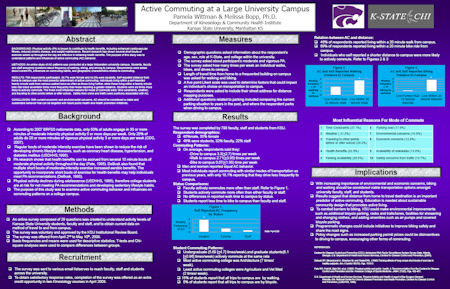Researchers at Kansas State University recently conducted a survey looking at active commuting at the university and surrounding community. The results of the survey suggest that KSU could improve its bicycling friendliness by adding bicycle parking, racks and trails/lanes, improving facilities for showering and changing clothes, and adding amenities such as air pumps and covered bicycle parking. The report also suggested biking safety education and “share the road” signs.
The report concluded that “With current economic and environmental concerns, active commuting should be considered a viable and sustainable behavior that can be targeted with future public health and health promotion initiatives.”

According to researchers with Kansas State University’s Physical Activity and Public Health Laboratory, active commuting — walking or biking to school or work — can be an easy, effective and efficient way to integrate physical activity into the daily routine.
Pam Wittman, a K-State senior in kinesiology, Olathe, worked with K-State’s Melissa Bopp and Andy Kaczynski, both assistant professors of kinesiology, on the active commuting research. The project included two surveys, administered in 2008, which looked at demographics, psychosocial factors and environmental characteristics related to active commuting. A survey of more than 800 individuals at K-State was conducted, followed by another survey of 400 Manhattan area residents.
The researchers say the results lay the groundwork for future policy discussions and for tailoring public health messages. Just 30 minutes of moderate physical activity a day is enough for health benefits, and small bouts of exercise throughout the day of as little as 10 minutes provide the health payoff, according to recently revised guidelines from the U.S. Department of Health and Human Services.
Among the campus findings: students were most likely to actively commute, then faculty members, and then staff. Women and men were equally interested in walking or biking. Older individuals were less likely to actively commute than younger individuals.
Depending on distance to campus, those living within a 20-minute walk actively commuted four times per week, and those within a 20-minute bike ride, biked to campus five times per week.
According to Bopp, many survey participants said they were willing to actively commute if they perceived they could travel to their destination in about 20 minutes — or a distance of approximately one mile.
The K-State researchers found a number of things that facilitated people’s choices to actively commute.
“We learned from the community survey results that people who hold ecologically-friendly attitudes are more likely to actively commute and less likely to drive to work,” Bopp said. The finding was interesting and she said future programs promoting active commuting could emphasize the eco-friendliness of it as a selling point.
Some of the hindrances to active commuting, according to the surveys, included a perceived lack of bike racks, showers or a place to freshen up before work or teaching, and an “office culture” where driving to work is the norm and there is limited support for walking or biking.
Respondents also listed time constraints, weather, a need to go elsewhere before or after work or school; parking availability; parking costs; concerns about the environment, such as pollution; cost of gasoline; safety from traffic and crime; and the terrain they have to traverse.
Kaczynski said that if bike lanes and sidewalks are a consideration of city and county engineers whenever roads have to be renovated it could benefit public health.
“In my opinion, changes to the physical environment that promote physical activity are investments, not costs,” he said. “Policymakers ought to weigh the cost of installing sidewalks or widening roads for bike lanes and the positive health benefits of physical activity.
“There are long-term economic costs to society of obesity, cancers and heart disease,” Kaczynski said. “There are emotional costs of people suffering because physical activity is actually being engineered out of our lives by having poor streets and other factors related to urban design.”
Mixed land use, where residential areas, commercial opportunities, parks, and workplaces are close and connected, provides more chances for people to engage in physical activity for leisure or for purposeful transportation, Kaczynski said.
“We see some areas of Manhattan where people can live, work and play all within a relatively short distance, but for large portions of Manhattan, such opportunities are limited by the way the neighborhoods are developed,” he said.
“Physical activity is a major public health concern. We need to take a new approach to integrating it back into our daily routines by designing communities that help meet these needs,” Kaczynski said. “We hope our study findings can help with that.”
Wittman has presented findings from the research at the Kansas Public Health Association conference, the K-State Sustainability Conference and the K-State Research Forum. She also has been selected to present at the American College of Sports Medicine conference in Seattle in May.
Bopp, Kaczynski and Wittman also have co-authored two other abstracts for presentation at national meetings: “Factors differentiating active versus non-active commuters to campus” and “The relationship of eco-friendly attitudes with walking and biking to work.”
Read more: K-State Survey Research Looks at Attitudes, Obstacles to Walking and Biking to Work.
See also: Active Commuting at a Large University Campus by Pamela Wittman & Melissa Bopp, Ph.D. (PDF).


